Dye Dale, O`neill Robert. The road to victory: From Pearl Harbor to Okinawa
Подождите немного. Документ загружается.

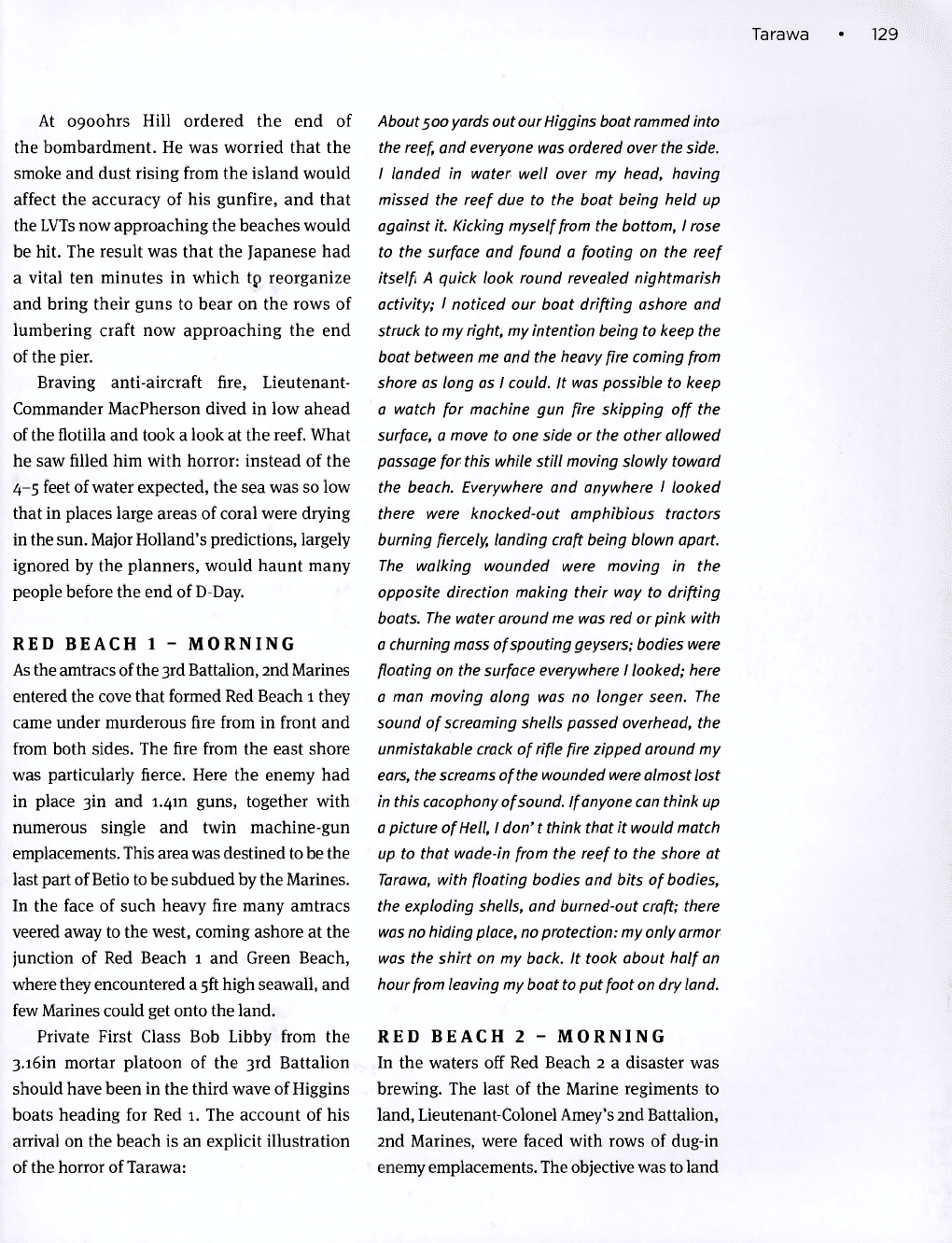
Tarawa • 129
At ogoohrs Hill ordered the end of
the bombardment. He was worried that the
smoke and dust rising from the island would
affect the accuracy of his gunfire, and that
the LVTs now approaching the beaches would
be hit. The result was that the Japanese had
a vital ten minutes in which tp reorganize
and bring their guns to bear on the rows of
lumbering craft now approaching the end
of the pier.
Braving anti-aircraft fire, Lieutenant-
Commander MacPherson dived in low ahead
of the flotilla and took a look at the reef. What
he saw filled him with horror: instead of the
4-5 feet of water expected, the sea was so low
that in places large areas of coral were drying
in the sun. Major Holland's predictions, largely
ignored by the planners, would haunt many
people before the end of D-Day.
RED BEACH 1 - MORNING
As the amtracs of the 3rd Battalion, 2nd Marines
entered the cove that formed Red Beach 1 they
came under murderous fire from in front and
from both sides. The fire from the east shore
was particularly fierce. Here the enemy had
in place 3in and 1.4m guns, together with
numerous single and twin machine-gun
emplacements. This area was destined to be the
last part of Betio to be subdued by the Marines.
In the face of such heavy fire many amtracs
veered away to the west, coming ashore at the
junction of Red Beach 1 and Green Beach,
where they encountered a
5ft
high seawall, and
few Marines could get onto the land.
Private First Class Bob Libby from the
3.i6in mortar platoon of the 3rd Battalion
should have been in the third wave of Higgins
boats heading for Red 1. The account of his
arrival on the beach is an explicit illustration
of the horror of Tarawa:
About 500 yards out our Higgins boat rammed into
the reef, and everyone was ordered over the side.
I landed in water well over my head, having
missed the reef due to the boat being held up
against
it.
Kicking myself from the bottom, I rose
to the surface and found a footing on the reef
itself. A quick look round revealed nightmarish
activity; I noticed our boat drifting ashore and
struck to my right, my intention being to keep the
boat between me and the heavy fire coming from
shore as long as I could. It was possible to keep
a watch for machine gun fire skipping off the
surface, a move to one side or the other allowed
passage for this while still moving slowly toward
the beach. Everywhere and anywhere I looked
there were knocked-out amphibious tractors
burning fiercely, landing craft being blown apart.
The walking wounded were moving in the
opposite direction making their way to drifting
boats. The water around me was red or pink with
a churning mass of spouting geysers; bodies were
floating on the surface everywhere I looked; here
a man moving along was no longer seen. The
sound of screaming shells passed overhead, the
unmistakable crack of rifle fire zipped around my
ears,
the
screams of the wounded
were
almost lost
in this cacophony of sound. If anyone can think up
a picture of Hell, I don't think that it would match
up to that wade-in from the reef
to
the shore at
Tarawa, with floating bodies and bits of bodies,
the exploding shells, and burned-out craft; there
was no hiding place, no protection: my only armor
was the shirt on my back. It took about half an
hour from leaving my boat
to
put foot on dryland.
RED BEACH 2 - MORNING
In the waters off Red Beach 2 a disaster was
brewing. The last of the Marine regiments to
land, Lieutenant-Colonel Amey's 2nd Battalion,
2nd Marines, were faced with rows of dug-in
enemy emplacements. The objective was to land
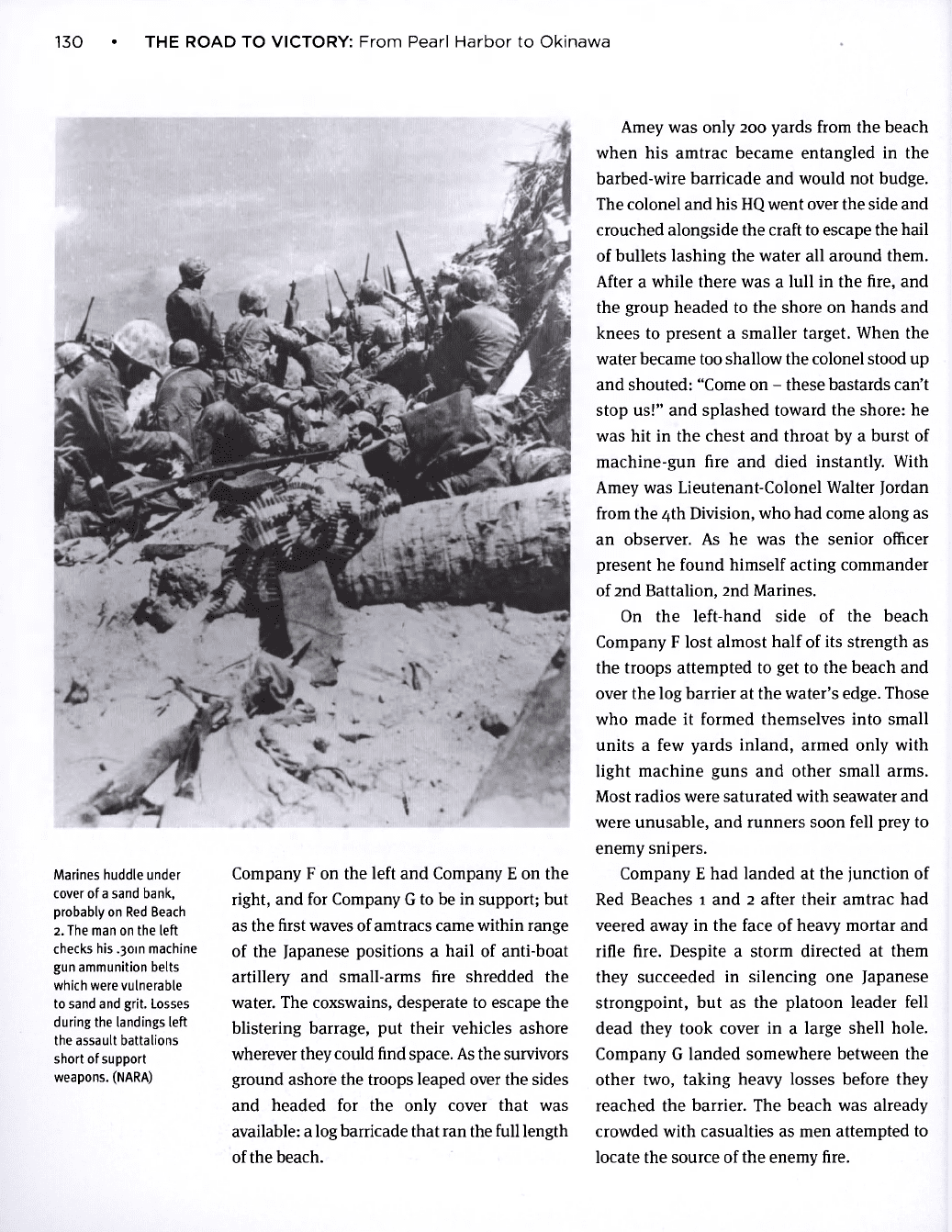
130 • THE ROAD TO VICTORY: From Pearl Harbor to Okinawa
Marines huddle under
cover of a sand bank,
probably on Red Beach
2. The man on the left
checks his .30m machine
gun ammunition belts
which were vulnerable
to sand and grit. Losses
during the landings left
the assault battalions
short of support
weapons. (NARA)
Company F on the left and Company E on the
right, and for Company G to be in support; but
as the first waves of amtracs came within range
of the Japanese positions a hail of anti-boat
artillery and small-arms fire shredded the
water. The coxswains, desperate to escape the
blistering barrage, put their vehicles ashore
wherever they could find space. As the survivors
ground ashore the troops leaped over the sides
and headed for the only cover that was
available: a log barricade that ran the full length
of the beach.
Amey was only 200 yards from the beach
when his amtrac became entangled in the
barbed-wire barricade and would not budge.
The colonel and his HQ went over the side and
crouched alongside the craft to escape the hail
of bullets lashing the water all around them.
After a while there was a lull in the fire, and
the group headed to the shore on hands and
knees to present a smaller target. When the
water became too shallow the colonel stood up
and shouted: "Come on - these bastards can't
stop us!" and splashed toward the shore: he
was hit in the chest and throat by a burst of
machine-gun fire and died instantly. With
Amey was Lieutenant-Colonel Walter Jordan
from the 4th Division, who had come along as
an observer. As he was the senior officer
present he found himself acting commander
of 2nd Battalion, 2nd Marines.
On the left-hand side of the beach
Company F lost almost half of its strength as
the troops attempted to get to the beach and
over the log barrier at the water's edge. Those
who made it formed themselves into small
units a few yards inland, armed only with
light machine guns and other small arms.
Most radios were saturated with seawater and
were unusable, and runners soon fell prey to
enemy snipers.
Company E had landed at the junction of
Red Beaches 1 and 2 after their amtrac had
veered away in the face of heavy mortar and
rifle fire. Despite a storm directed at them
they succeeded in silencing one Japanese
strongpoint, but as the platoon leader fell
dead they took cover in a large shell hole.
Company G landed somewhere between the
other two, taking heavy losses before they
reached the barrier. The beach was already
crowded with casualties as men attempted to
locate the source of the enemy fire.
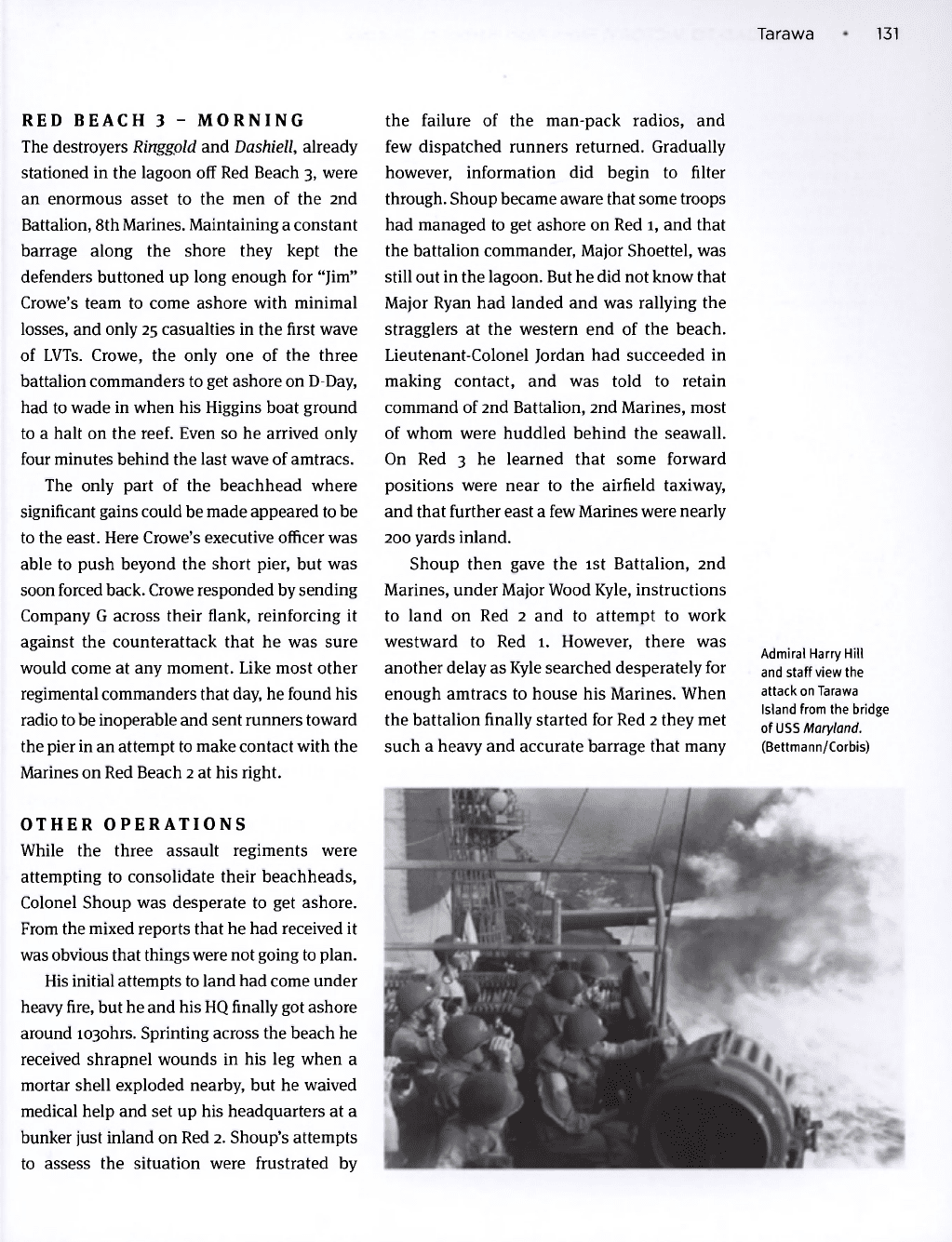
Tarawa • 131
RED BEACH 3 - MORNING
The destroyers Ringgold and Dashiell, already
stationed in the lagoon off Red Beach 3, were
an enormous asset to the men of the 2nd
Battalion, 8th Marines. Maintaining a constant
barrage along the shore they kept the
defenders buttoned up long enough for "Jim"
Crowe's team to come ashore with minimal
losses, and only 25 casualties in the first wave
of LVTs. Crowe, the only one of the three
battalion commanders to get ashore on D-Day,
had to wade in when his Higgins boat ground
to a halt on the reef. Even so he arrived only
four minutes behind the last wave of amtracs.
The only part of the beachhead where
significant gains could be made appeared to be
to the east. Here Crowe's executive officer was
able to push beyond the short pier, but was
soon forced back. Crowe responded by sending
Company G across their flank, reinforcing it
against the counterattack that he was sure
would come at any moment. Like most other
regimental commanders that day, he found his
radio to be inoperable and sent runners toward
the pier in an attempt to make contact with the
Marines on Red Beach 2 at his right.
OTHER OPERATIONS
While the three assault regiments were
attempting to consolidate their beachheads,
Colonel Shoup was desperate to get ashore.
From the mixed reports that he had received it
was obvious that things were not going to plan.
His initial attempts to land had come under
heavy fire, but he and his HQ finally got ashore
around i030hrs. Sprinting across the beach he
received shrapnel wounds in his leg when a
mortar shell exploded nearby, but he waived
medical help and set up his headquarters at a
bunker just inland on Red 2. Shoup's attempts
to assess the situation were frustrated by
the failure of the man-pack radios, and
few dispatched runners returned. Gradually
however, information did begin to filter
through. Shoup became aware that some troops
had managed to get ashore on Red 1, and that
the battalion commander, Major Shoettel, was
still out in the lagoon. But he did not know that
Major Ryan had landed and was rallying the
stragglers at the western end of the beach.
Lieutenant-Colonel Jordan had succeeded in
making contact, and was told to retain
command of 2nd Battalion, 2nd Marines, most
of whom were huddled behind the seawall.
On Red 3 he learned that some forward
positions were near to the airfield taxiway,
and that further east a few Marines were nearly
200 yards inland.
Shoup then gave the 1st Battalion, 2nd
Marines, under Major Wood Kyle, instructions
to land on Red 2 and to attempt to work
westward to Red 1. However, there was
another delay as Kyle searched desperately for
enough amtracs to house his Marines. When
the battalion finally started for Red 2 they met
such a heavy and accurate barrage that many
Admiral Harry Hill
and staff view the
attack on Tarawa
Island from the bridge
of USS Maryland.
(Bettmann/Corbis)
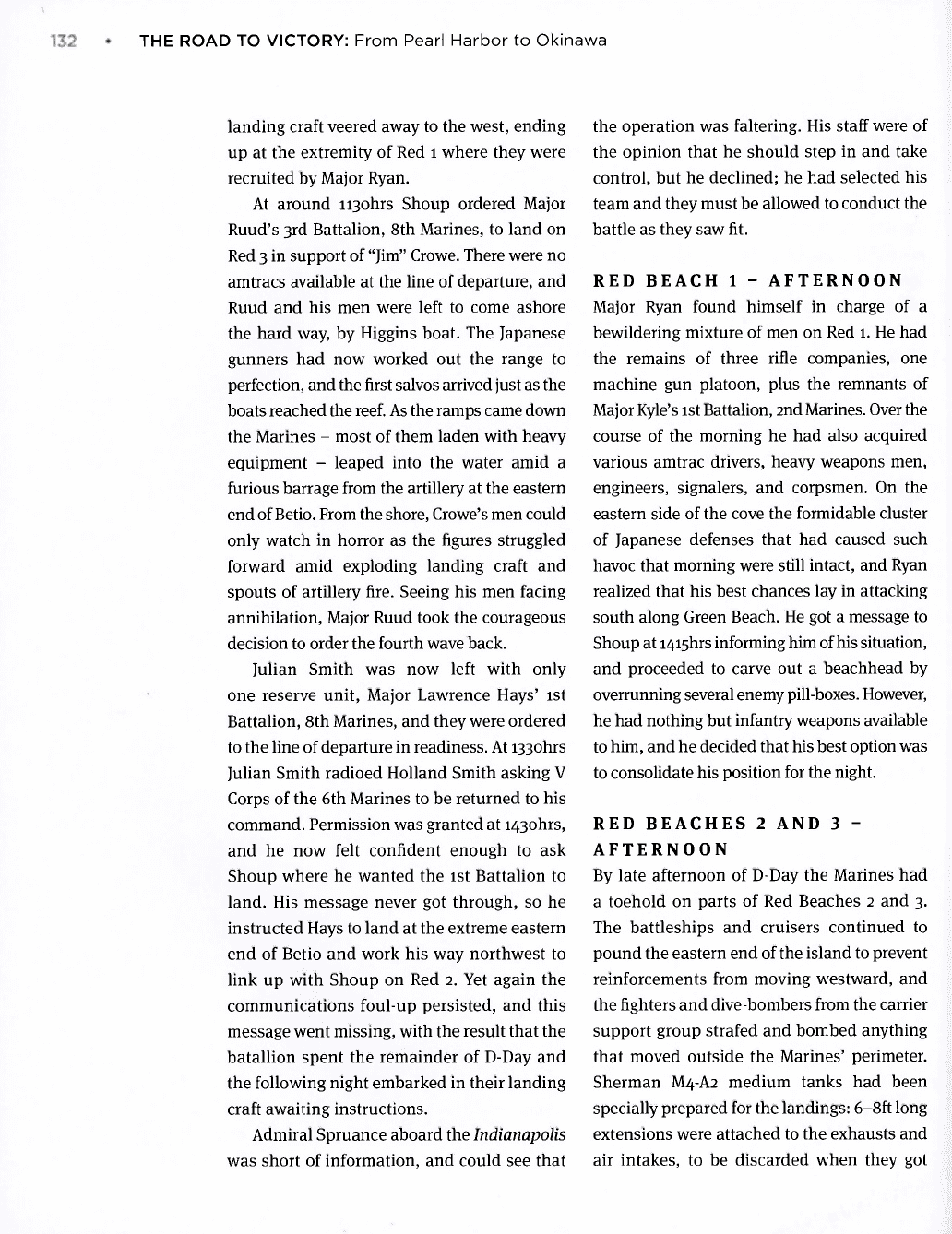
236 • THE ROAD TO VICTORY: From Pearl Harbor to Okinawa
landing craft veered away to the west, ending
up at the extremity of Red 1 where they were
recruited by Major Ryan.
At around ii3ohrs Shoup ordered Major
Ruud's 3rd Battalion, 8th Marines, to land on
Red 3 in support of "Jim" Crowe. There were no
amtracs available at the line of departure, and
Ruud and his men were left to come ashore
the hard way, by Higgins boat. The Japanese
gunners had now worked out the range to
perfection, and the first salvos arrived just as the
boats reached the reef. As the ramps came down
the Marines - most of them laden with heavy
equipment - leaped into the water amid a
furious barrage from the artillery at the eastern
end of
Betio.
From the shore, Crowe's men could
only watch in horror as the figures struggled
forward amid exploding landing craft and
spouts of artillery fire. Seeing his men facing
annihilation, Major Ruud took the courageous
decision to order the fourth wave back.
Julian Smith was now left with only
one reserve unit, Major Lawrence Hays' 1st
Battalion, 8th Marines, and they were ordered
to the line of departure in readiness. At i33ohrs
Julian Smith radioed Holland Smith asking V
Corps of the 6th Marines to be returned to his
command. Permission was granted at i43ohrs,
and he now felt confident enough to ask
Shoup where he wanted the 1st Battalion to
land. His message never got through, so he
instructed Hays to land at the extreme eastern
end of Betio and work his way northwest to
link up with Shoup on Red 2. Yet again the
communications foul-up persisted, and this
message went missing, with the result that the
batallion spent the remainder of D-Day and
the following night embarked in their landing
craft awaiting instructions.
Admiral Spruance aboard the Indianapolis
was short of information, and could see that
the operation was faltering. His staff were of
the opinion that he should step in and take
control, but he declined; he had selected his
team and they must be allowed to conduct the
battle as they saw fit.
RED BEACH 1 - AFTERNOON
Major Ryan found himself in charge of a
bewildering mixture of men on Red 1. He had
the remains of three rifle companies, one
machine gun platoon, plus the remnants of
Major Kyle's 1st Battalion, 2nd Marines. Over the
course of the morning he had also acquired
various amtrac drivers, heavy weapons men,
engineers, signalers, and corpsmen. On the
eastern side of the cove the formidable cluster
of Japanese defenses that had caused such
havoc that morning were still intact, and Ryan
realized that his best chances lay in attacking
south along Green Beach. He got a message to
Shoup at i/
(
i5hrs informing him of his situation,
and proceeded to carve out a beachhead by
overrunning several enemy pill-boxes. However,
he had nothing but infantry weapons available
to him, and he decided that his best option was
to consolidate his position for the night.
RED BEACHES 2 AND 3 -
AFTERNOON
By late afternoon of D-Day the Marines had
a toehold on parts of Red Beaches 2 and 3.
The battleships and cruisers continued to
pound the eastern end of the island to prevent
reinforcements from moving westward, and
the fighters and dive-bombers from the carrier
support group strafed and bombed anything
that moved outside the Marines' perimeter.
Sherman M4-A2 medium tanks had been
specially prepared for the landings:
6—8ft
long
extensions were attached to the exhausts and
air intakes, to be discarded when they got
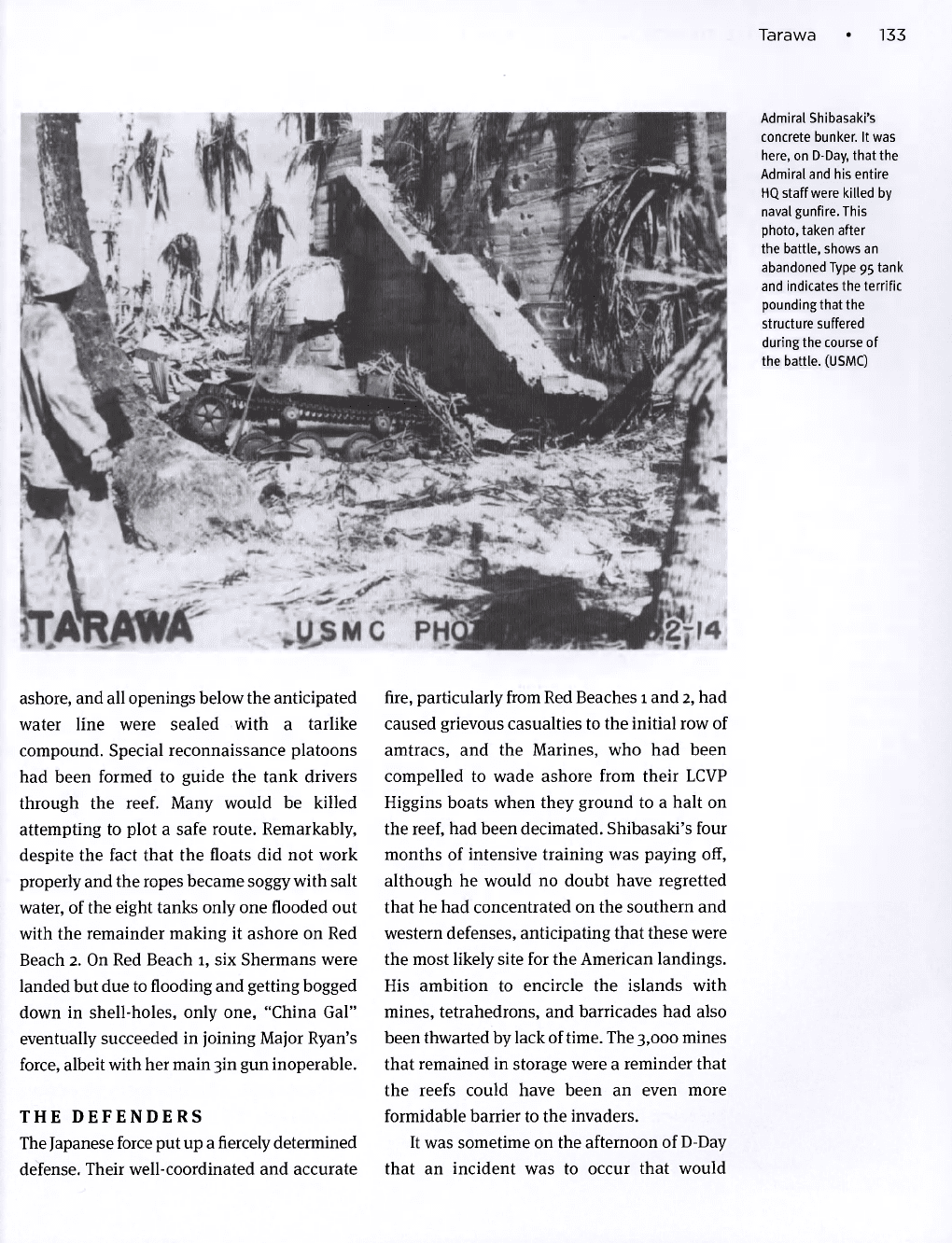
Tarawa • 133
Admiral Shibasaki's
concrete bunker. It was
here, on D-Day, that the
Admiral and his entire
HQ staff were killed by
naval gunfire. This
photo, taken after
the battle, shows an
abandoned Type 95 tank
and indicates the terrific
poundingthatthe
structure suffered
during the course of
the battle. (USMC)
ashore, and all openings below the anticipated
water line were sealed with a tarlike
compound. Special reconnaissance platoons
had been formed to guide the tank drivers
through the reef. Many would be killed
attempting to plot a safe route. Remarkably,
despite the fact that the floats did not work
properly and the ropes became soggy with salt
water, of the eight tanks only one flooded out
with the remainder making it ashore on Red
Beach 2. On Red Beach 1, six Shermans were
landed but due to flooding and getting bogged
down in shell-holes, only one, "China Gal"
eventually succeeded in joining Major Ryan's
force, albeit with her main 3in gun inoperable.
THE DEFENDERS
The Japanese force put up a fiercely determined
defense. Their well-coordinated and accurate
fire, particularly from Red Beaches 1 and 2, had
caused grievous casualties to the initial row of
amtracs, and the Marines, who had been
compelled to wade ashore from their LCVP
Higgins boats when they ground to a halt on
the reef, had been decimated. Shibasaki's four
months of intensive training was paying off,
although he would no doubt have regretted
that he had concentrated on the southern and
western defenses, anticipating that these were
the most likely site for the American landings.
His ambition to encircle the islands with
mines, tetrahedrons, and barricades had also
been thwarted by lack of time. The 3,000 mines
that remained in storage were a reminder that
the reefs could have been an even more
formidable barrier to the invaders.
It was sometime on the afternoon of D-Day
that an incident was to occur that would
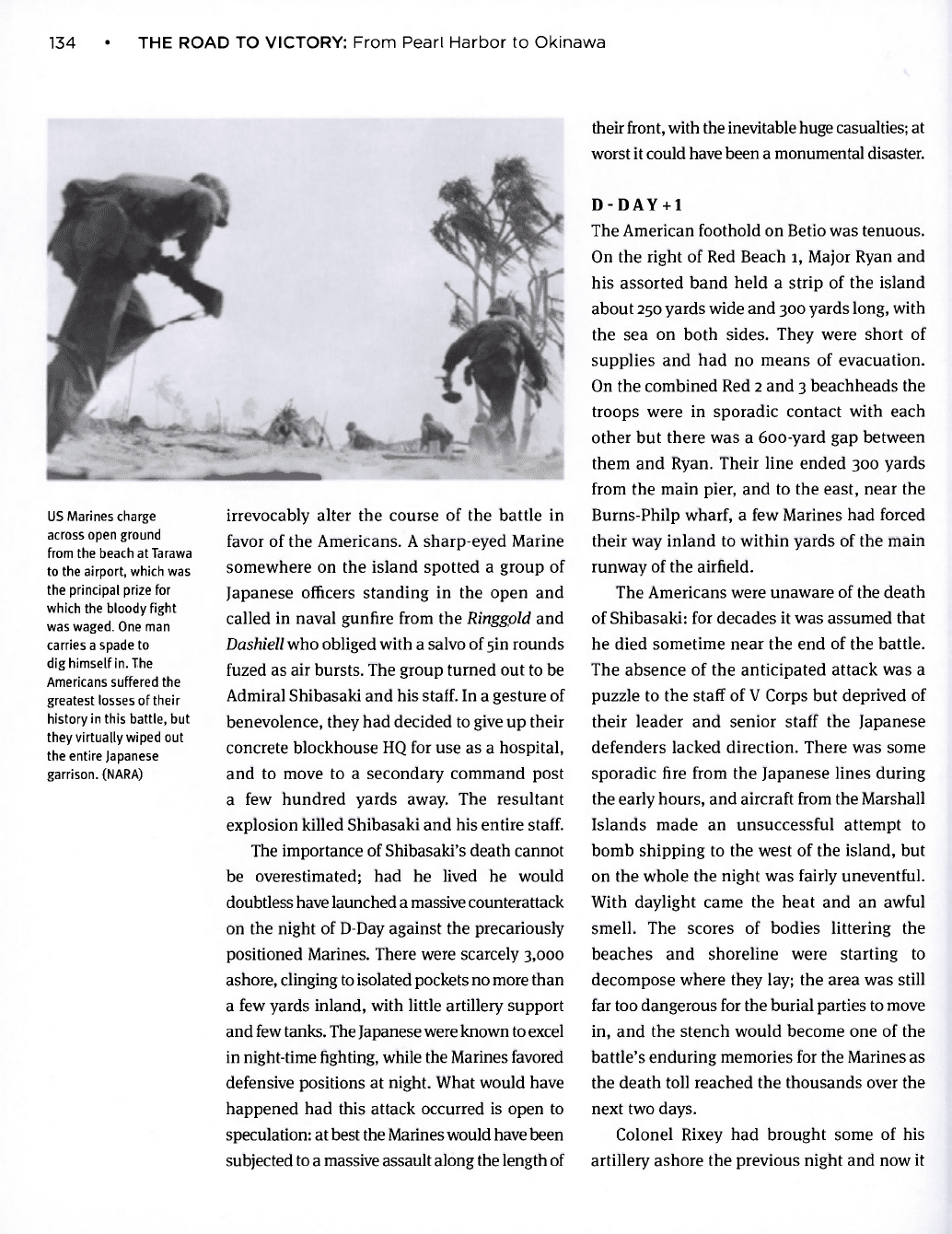
134 • THE ROAD TO VICTORY: From Pearl Harbor to Okinawa
US Marines charge
across open ground
from the beach at Tarawa
to the airport, which was
the principal prize for
which the bloody fight
was waged. One man
carries a spade to
dig himself in. The
Americans suffered the
greatest losses of their
history in this battle, but
they virtually wiped out
the entire Japanese
garrison. (NARA)
irrevocably alter the course of the battle in
favor of the Americans. A sharp-eyed Marine
somewhere on the island spotted a group of
Japanese officers standing in the open and
called in naval gunfire from the Ringgold and
Dashiell who obliged with a salvo of sin rounds
fuzed as air bursts. The group turned out to be
Admiral Shibasaki and his staff. In a gesture of
benevolence, they had decided to give up their
concrete blockhouse HQ for use as a hospital,
and to move to a secondary command post
a few hundred yards away. The resultant
explosion killed Shibasaki and his entire staff.
The importance of Shibasaki's death cannot
be overestimated; had he lived he would
doubtless have launched a massive counterattack
on the night of D-Day against the precariously
positioned Marines. There were scarcely 3,000
ashore, clinging to isolated pockets no more than
a few yards inland, with little artillery support
and few tanks. The Japanese were known
to
excel
in night-time fighting, while the Marines favored
defensive positions at night. What would have
happened had this attack occurred is open to
speculation: at best the Marines would have been
subjected to a massive assault along the length of
their
front,
with the inevitable huge casualties; at
worst it could have been a monumental disaster.
D - DAY
+
1
The American foothold on Betio was tenuous.
On the right of Red Beach 1, Major Ryan and
his assorted band held a strip of the island
about 250 yards wide and 300 yards long, with
the sea on both sides. They were short of
supplies and had no means of evacuation.
On the combined Red 2 and 3 beachheads the
troops were in sporadic contact with each
other but there was a 600-yard gap between
them and Ryan. Their line ended 300 yards
from the main pier, and to the east, near the
Burns-Philp wharf, a few Marines had forced
their way inland to within yards of the main
runway of the airfield.
The Americans were unaware of the death
of Shibasaki: for decades it was assumed that
he died sometime near the end of the battle.
The absence of the anticipated attack was a
puzzle to the staff of V Corps but deprived of
their leader and senior staff the Japanese
defenders lacked direction. There was some
sporadic fire from the Japanese lines during
the early hours, and aircraft from the Marshall
Islands made an unsuccessful attempt to
bomb shipping to the west of the island, but
on the whole the night was fairly uneventful.
With daylight came the heat and an awful
smell. The scores of bodies littering the
beaches and shoreline were starting to
decompose where they lay; the area was still
far too dangerous for the burial parties to move
in, and the stench would become one of the
battle's enduring memories for the Marines as
the death toll reached the thousands over the
next two days.
Colonel Rixey had brought some of his
artillery ashore the previous night and now it
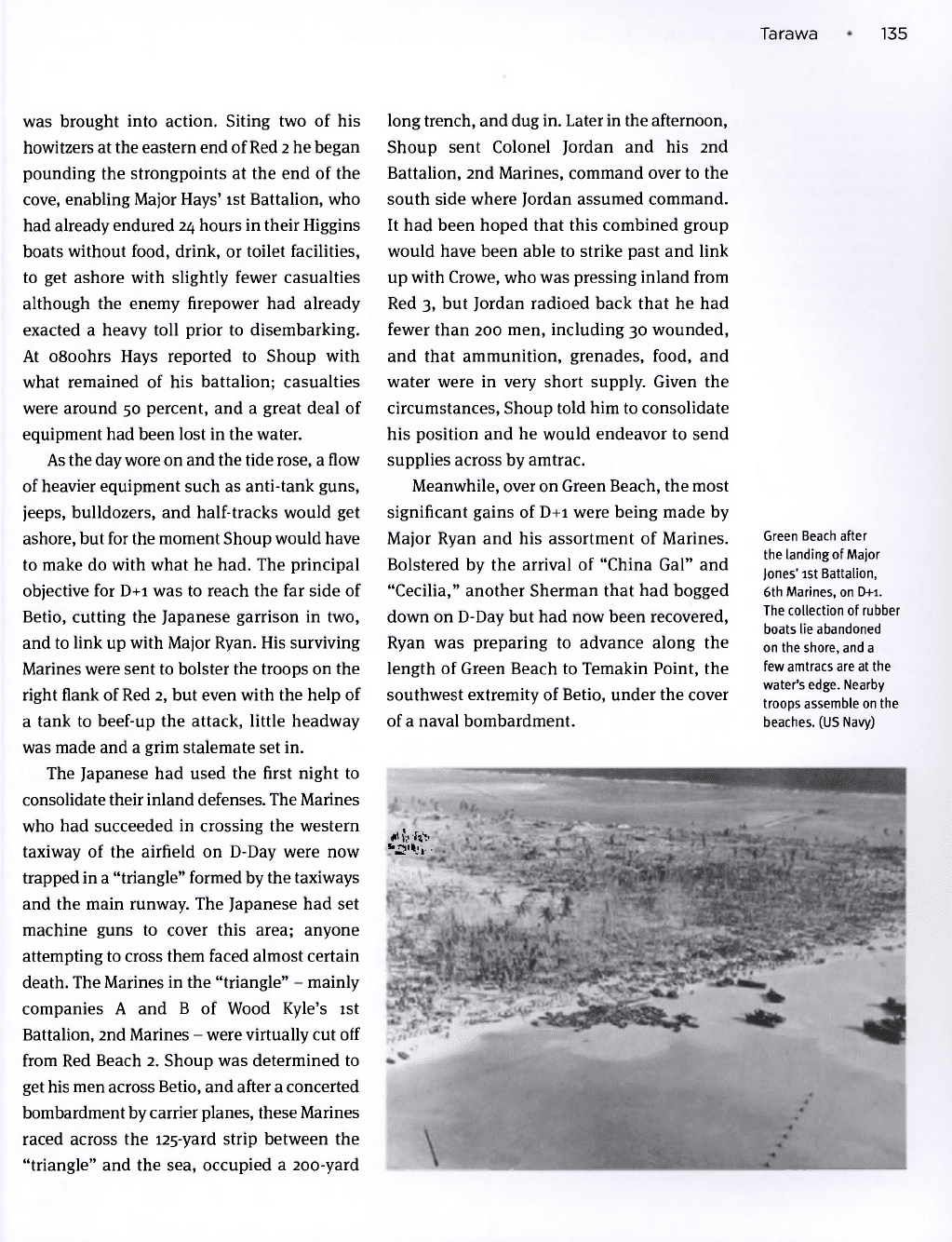
Tarawa • 135
was brought into action. Siting two of his
howitzers at the eastern end of Red 2 he began
pounding the strongpoints at the end of the
cove, enabling Major Hays' 1st Battalion, who
had already endured 24 hours in their Higgins
boats without food, drink, or toilet facilities,
to get ashore with slightly fewer casualties
although the enemy firepower had already
exacted a heavy toll prior to disembarking.
At o8oohrs Hays reported to Shoup with
what remained of his battalion; casualties
were around 50 percent, and a great deal of
equipment had been lost in the water.
As the day wore on and the tide rose, a flow
of heavier equipment such as anti-tank guns,
jeeps, bulldozers, and half-tracks would get
ashore, but for the moment Shoup would have
to make do with what he had. The principal
objective for D+i was to reach the far side of
Betio, cutting the Japanese garrison in two,
and to link up with Major Ryan. His surviving
Marines were sent to bolster the troops on the
right flank of Red 2, but even with the help of
a tank to beef-up the attack, little headway
was made and a grim stalemate set in.
The Japanese had used the first night to
consolidate their inland defenses. The Marines
who had succeeded in crossing the western
taxiway of the airfield on D-Day were now
trapped in a "triangle" formed by the taxiways
and the main runway. The Japanese had set
machine guns to cover this area; anyone
attempting to cross them faced almost certain
death. The Marines in the "triangle" - mainly
companies A and B of Wood Kyle's 1st
Battalion, 2nd Marines - were virtually cut off
from Red Beach 2. Shoup was determined to
get his men across Betio, and after a concerted
bombardment by carrier planes, these Marines
raced across the 125-yard strip between the
"triangle" and the sea, occupied a 200-yard
long trench, and dug in. Later in the afternoon,
Shoup sent Colonel Jordan and his 2nd
Battalion, 2nd Marines, command over to the
south side where Jordan assumed command.
It had been hoped that this combined group
would have been able to strike past and link
up with Crowe, who was pressing inland from
Red 3, but Jordan radioed back that he had
fewer than 200 men, including 30 wounded,
and that ammunition, grenades, food, and
water were in very short supply. Given the
circumstances, Shoup told him to consolidate
his position and he would endeavor to send
supplies across by amtrac.
Meanwhile, over on Green Beach, the most
significant gains of D+i were being made by
Major Ryan and his assortment of Marines.
Bolstered by the arrival of "China Gal" and
"Cecilia," another Sherman that had bogged
down on D-Day but had now been recovered,
Ryan was preparing to advance along the
length of Green Beach to Temakin Point, the
southwest extremity of Betio, under the cover
of a naval bombardment.
Green Beach after
the landing of Major
Jones' 1st Battalion,
6th Marines, on D+i.
The collection of rubber
boats lie abandoned
on the shore, and a
few amtracs are at the
water's edge. Nearby
troops assemble on the
beaches. (US Navy)
dfc to
"^'Vi-
-
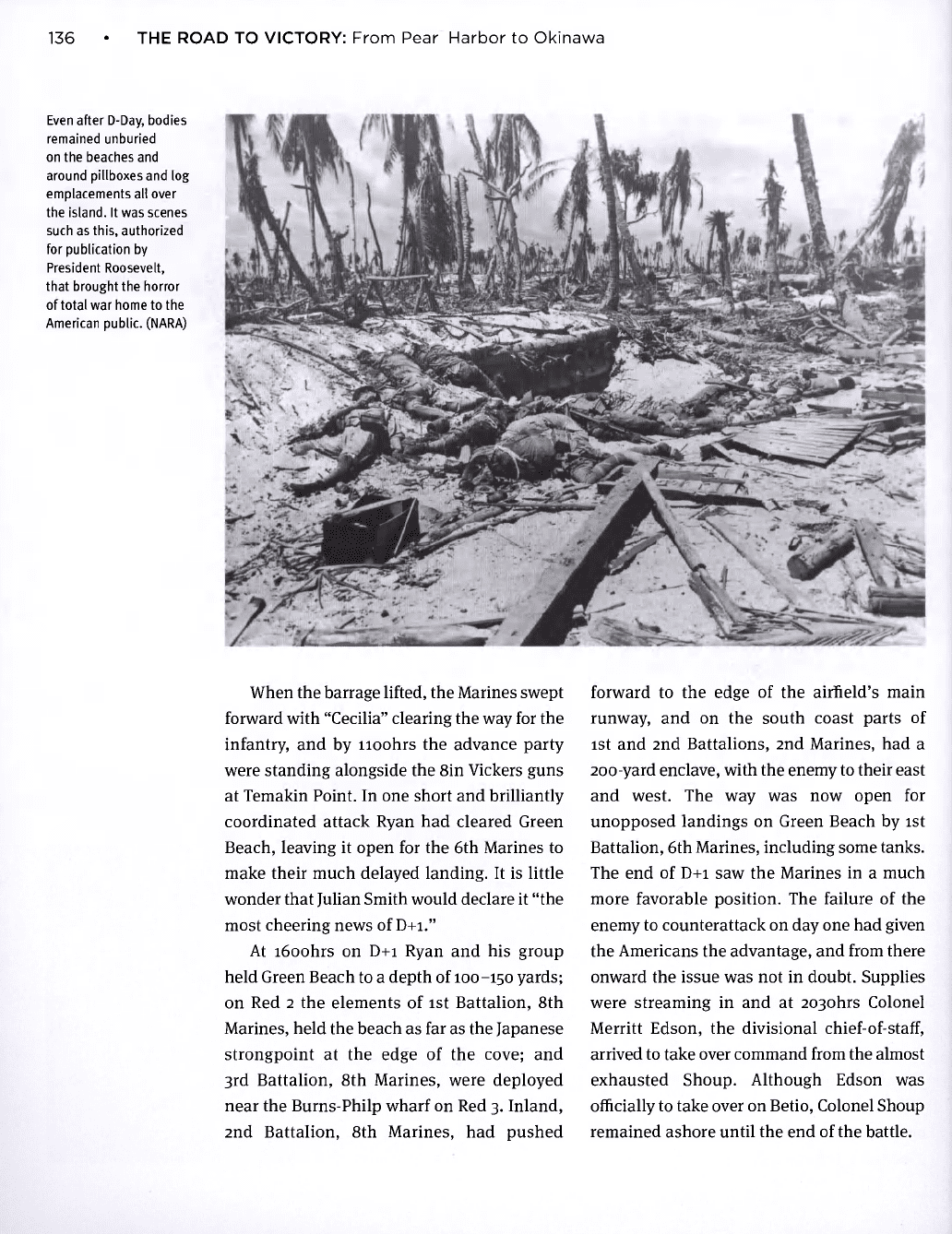
136 • THE ROAD TO VICTORY: From Pearl Harbor to Okinawa
Even after D-Day, bodies
remained unburied
on the beaches and
around pillboxes and log
emplacements all over
the island. It was scenes
such as this, authorized
for publication by
President Roosevelt,
that brought the horror
of total war home to the
American public. (NARA)
When the barrage lifted, the Marines swept
forward with "Cecilia" clearing the way for the
infantry, and by lioohrs the advance party
were standing alongside the 8in Vickers guns
at Temakin Point. In one short and brilliantly
coordinated attack Ryan had cleared Green
Beach, leaving it open for the 6th Marines to
make their much delayed landing. It is little
wonder that Julian Smith would declare it "the
most cheering news of D+i."
At i6oohrs on D+i Ryan and his group
held Green Beach to a depth of 100-150 yards;
on Red 2 the elements of 1st Battalion, 8th
Marines, held the beach as far as the Japanese
strongpoint at the edge of the cove; and
3rd Battalion, 8th Marines, were deployed
near the Burns-Philp wharf on Red 3. Inland,
2nd Battalion, 8th Marines, had pushed
forward to the edge of the airfield's main
runway, and on the south coast parts of
1st and 2nd Battalions, 2nd Marines, had a
200-yard enclave, with the enemy to their east
and west. The way was now open for
unopposed landings on Green Beach by 1st
Battalion, 6th Marines, including some tanks.
The end of D+i saw the Marines in a much
more favorable position. The failure of the
enemy to counterattack on day one had given
the Americans the advantage, and from there
onward the issue was not in doubt. Supplies
were streaming in and at 2030hrs Colonel
Merritt Edson, the divisional chief-of-staff,
arrived to take over command from the almost
exhausted Shoup. Although Edson was
officially to take over on Betio, Colonel Shoup
remained ashore until the end of the battle.
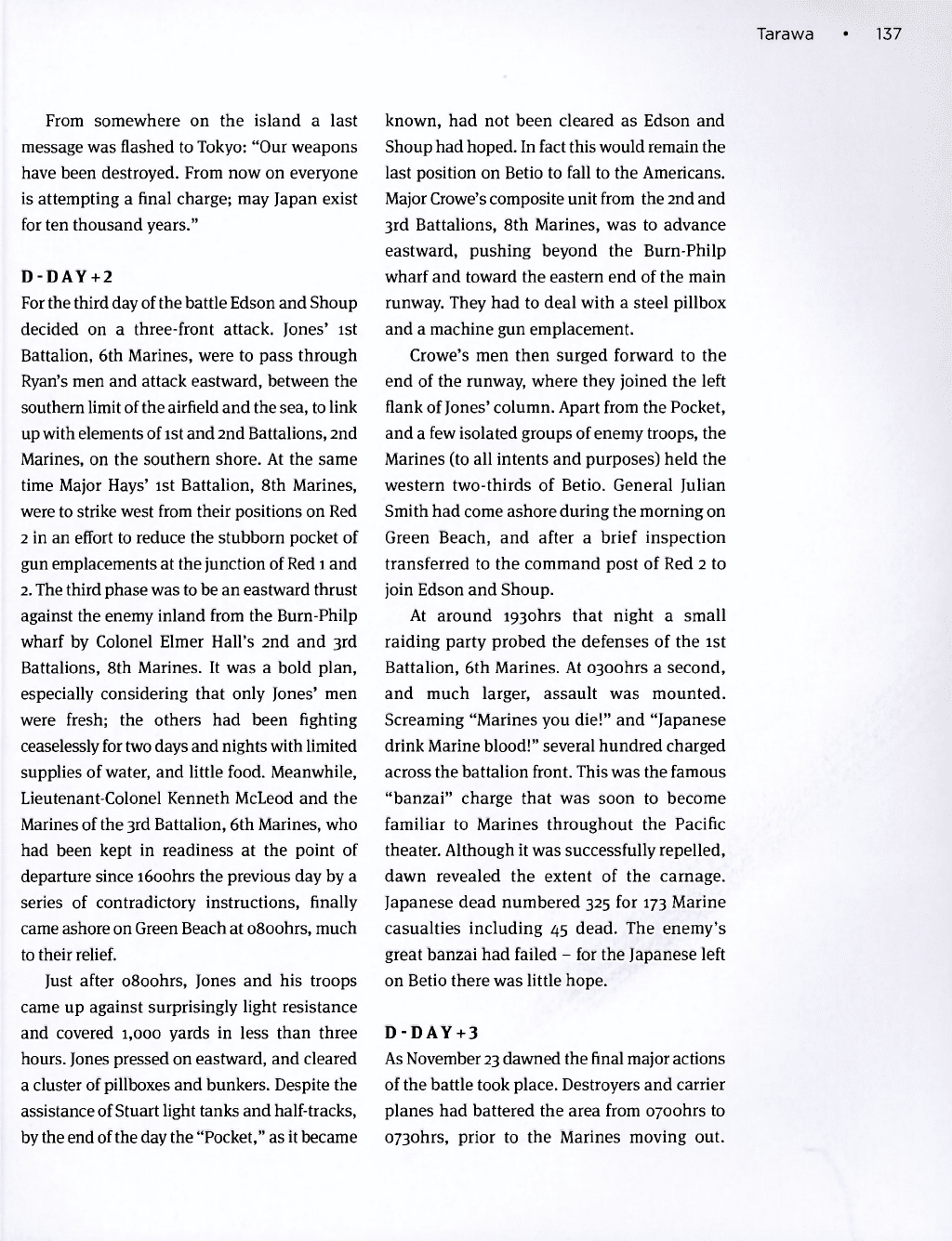
Tarawa • 137
From somewhere on the island a last
message was flashed to Tokyo: "Our weapons
have been destroyed. From now on everyone
is attempting a final charge; may Japan exist
for ten thousand years."
D - DAY +2
For the third day of the battle Edson and Shoup
decided on a three-front attack. Jones' ist
Battalion, 6th Marines, were to pass through
Ryan's men and attack eastward, between the
southern limit of the airfield and the sea, to link
up with elements of ist and 2nd Battalions, 2nd
Marines, on the southern shore. At the same
time Major Hays' ist Battalion, 8th Marines,
were to strike west from their positions on Red
2 in an effort to reduce the stubborn pocket of
gun emplacements at the junction of Red l and
2. The third phase was to be an eastward thrust
against the enemy inland from the Burn-Philp
wharf by Colonel Elmer Hall's 2nd and 3rd
Battalions, 8th Marines. It was a bold plan,
especially considering that only Jones' men
were fresh; the others had been fighting
ceaselessly for two days and nights with limited
supplies of water, and little food. Meanwhile,
Lieutenant-Colonel Kenneth McLeod and the
Marines of the 3rd Battalion, 6th Marines, who
had been kept in readiness at the point of
departure since i6oohrs the previous day by a
series of contradictory instructions, finally
came ashore on Green Beach at o8oohrs, much
to their relief.
Just after o8oohrs, Jones and his troops
came up against surprisingly light resistance
and covered 1,000 yards in less than three
hours. Jones pressed on eastward, and cleared
a cluster of pillboxes and bunkers. Despite the
assistance of Stuart light tanks and half-tracks,
by the end of the day the "Pocket," as it became
known, had not been cleared as Edson and
Shoup had hoped. In fact this would remain the
last position on Betio to fall to the Americans.
Major Crowe's composite unit from the 2nd and
3rd Battalions, 8th Marines, was to advance
eastward, pushing beyond the Burn-Philp
wharf and toward the eastern end of the main
runway. They had to deal with a steel pillbox
and a machine gun emplacement.
Crowe's men then surged forward to the
end of the runway, where they joined the left
flank of Jones' column. Apart from the Pocket,
and a few isolated groups of enemy troops, the
Marines (to all intents and purposes) held the
western two-thirds of Betio. General Julian
Smith had come ashore during the morning on
Green Beach, and after a brief inspection
transferred to the command post of Red 2 to
join Edson and Shoup.
At around i93ohrs that night a small
raiding party probed the defenses of the 1st
Battalion, 6th Marines. At 0300hrs a second,
and much larger, assault was mounted.
Screaming "Marines you die!" and "Japanese
drink Marine blood!" several hundred charged
across the battalion front. This was the famous
"banzai" charge that was soon to become
familiar to Marines throughout the Pacific
theater. Although it was successfully repelled,
dawn revealed the extent of the carnage.
Japanese dead numbered 325 for 173 Marine
casualties including 45 dead. The enemy's
great banzai had failed - for the Japanese left
on Betio there was little hope.
D-DAY +3
As November 23 dawned the final major actions
of the battle took place. Destroyers and carrier
planes had battered the area from ozoohrs to
0730hrs, prior to the Marines moving out.
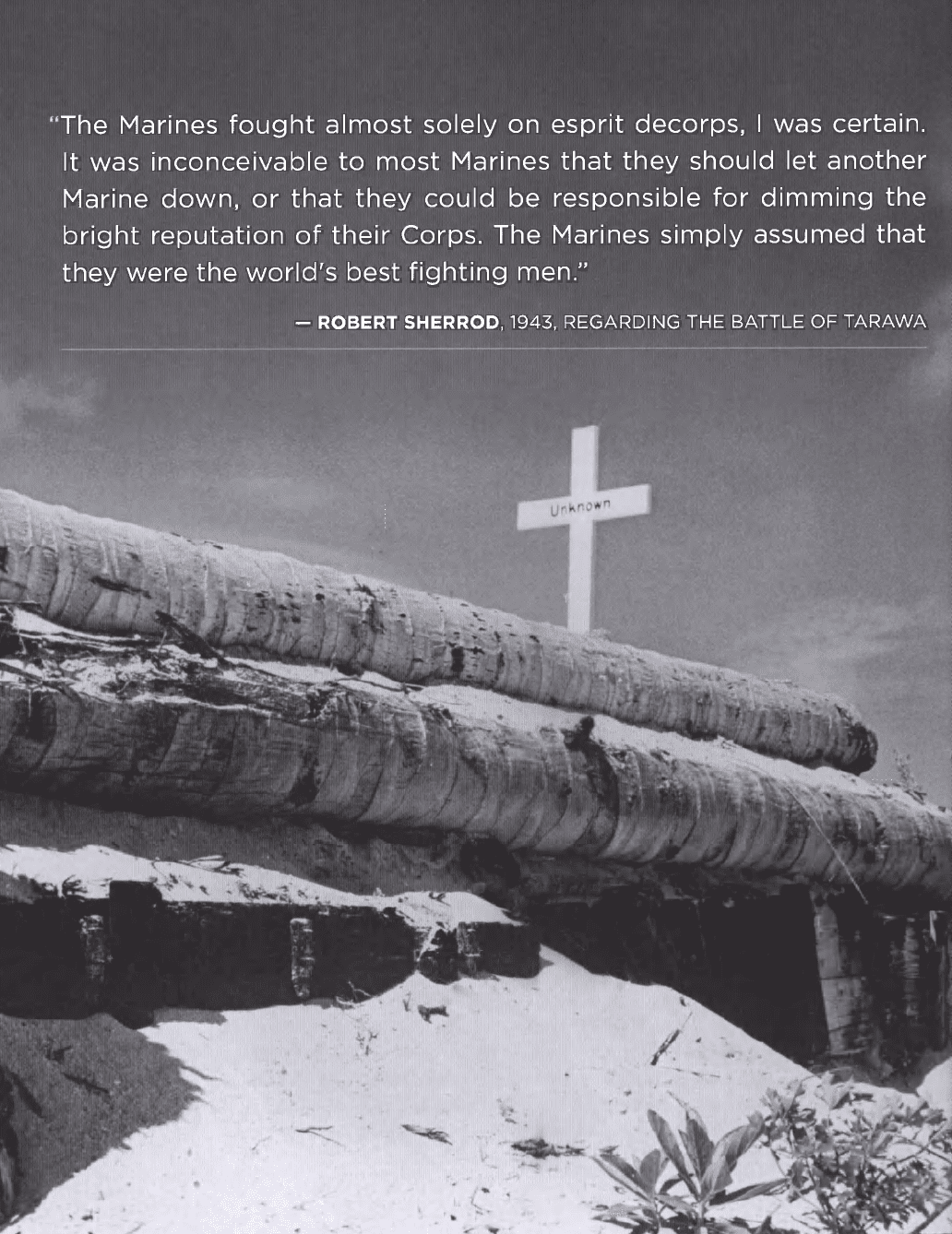
The Marines fought almost solely on esprit decorps, I was certain.
It was inconceivable to most Marines that they should let another
Marine down, or that they could be responsible for dimming the
bright reputation of their Corps. The Marines simply assumed that
they were the world's best fighting men."
- ROBERT SHERROD, 1943, REGARDING THE BATTLE OF TARAWA
